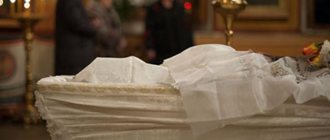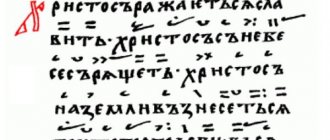The meaning of bread in church rituals
In his message, John (John 6:18) conveys the words of the Savior that He is the Bread of Life. It was not for nothing that the Lord compared himself to bread. This word has a deep meaning.
- The grain dies and is reborn in the ear. So Jesus died to return to earth in the hearts of His children, Orthodox Christians.
- Flour is a symbol of purification and processing, in order to become a prototype of the Savior, believers must pass tests and unite into one whole, one Church, the bride of Christ.
- Baking is purification by fire.
- A bread product contains many pieces, just as Jesus united his followers.
Orthodox sacred bread
Just as bread is a staple food for people, remaining the main dish on the table, so Jesus Christ is the basis and center of the Church. True believing Orthodox people begin their day with prayer and eating holy water and a piece of church bread on an empty stomach:
- prosphora;
- arthos.
Important!
Daily consumption of the Bread of Heaven opens the way to Eternal Life. More about the shrines of Orthodoxy:
- Miraculous icons of Athos
- Relics of Saint John the Baptist
- Relics of Saint Ambrose of Optina
Prosphora, its meaning and history of appearance
Prosphora is an integral part of the Liturgy; it is also called liturgical bread. The sacrament of the Eucharist, the commemoration of the deceased at Proskomedia, occurs during the reception of holy bread by Christians - a piece of prosphora.
The first mention of church bread prepared for sacrifice is in the Old Testament (Leviticus 7:13), when God ordered leavened baked goods to be prepared for sacrifice. In the tabernacle, during the campaign of Moses and the Jewish people through the desert, also by command of the Creator, there was always the bread of show, but unleavened. It had two parts - symbols of earthly human life and heavenly Divine life. The showbread is a type of Jesus, who became the Bread of Life, being God and man.
Prosphora breads are baked by specially trained people, prosphora bakers, and at large churches there are prosphora bakeries where holy bread is baked. The recipe for church baked goods is based on holy water, wheat flour, leaven and salt. Hops, raisins or ordinary yeast are used as starter culture.
Holy water is a symbol of grace, leaven is the life-giving power of the Holy Spirit.
Important! A distinctive feature of the prosphora from other bread products in the church is the symbolic abbreviation placed in the middle of the upper part.
Prosphora
To apply an image signifying that Christ is victorious, special forms are used. The holy loaf consists of two parts, as in Old Testament times, symbolizing Jesus both man and God.
Five prosphoras are prepared for Proskomedia, each of which has its own purpose. From one, as a prototype of the Lamb, pieces are taken out for the communion of believers; the other pays tribute to the memory of the Mother of God, saints and deceased people.
After the end of the Liturgy, believers eat prosphora with reverent prayer and reverence, communing with the body of Christ, accepting His sacrifice for the life of all believers. The remaining pieces of prosphora - antidor - are distributed to parishioners to take after morning prayers.
OB ANTIDORA.
Antidor (άντιδῶρον - instead of gift) are the remains of that prosphora, from which the middle was taken out for the lamb and sacrificed as a bloodless sacrifice. Simeon of Thessalonica (about the temple. Ch. 101) describes it this way: “Antidor is sacred bread, from which the internal parts are removed at the proskomedia and brought into the body of Christ in sacred rites.” According to the establishment of the church, the antidor should be distributed instead of St. gifts to all those present in the church during the liturgy and those who do not partake of St. secret . The reasons for this establishment were as follows. In the primal church, all Christian believers present in the church during the liturgy had the pious custom of receiving Holy Communion. secret. This custom was so strictly observed that deviating from it entailed severe punishment.
According to the ninth apostolic canon, “all the faithful who enter God’s holy church and listen to the sacred scriptures, but do not remain in prayer and holy communion to the end, as if they are committing disorderly acts, must be subject to excommunication.” The same was confirmed by the Council of Antioch, according to the second rule of which “everyone who enters the church and listens to the sacred scriptures, but due to some deviation from order does not participate in prayer with the people or abstains from communion of the holy Eucharist, must be from expelled from the church."
Over time, when jealousy and ardor among Christians began to cool, this pious and strictly observed custom in the first centuries began to weaken little by little. Already St. John Chrysostom strongly complained that many Christians only wanted to be present at the celebration of the liturgy, without receiving Holy Communion. secret. Although many began to shy away from St. communion under the pretext of consciousness of his unworthiness, but St. the father strongly reproached such Christians, calling them shameless and unworthy of fellowship in prayer (in the 3rd conversation on the Epistle to Ephesus). No matter how great was the zeal for the piety of St. John Chrysostom, no matter how powerful his word was, he could not ensure that all Christians present in the church during the liturgy received Holy Communion. secret; and after his death, the deviation from the communion of St. became even more noticeable among Christians. the mysteries behind every liturgy. Therefore, the pastors of the church were forced to show condescension to human weakness - they allowed the faithful, following the example of the repentants and who were called standing with the faithful, to be present at the celebration of the liturgy even without the communion of St. secret. Showing such condescension to human weakness , St. The fathers and teachers of the church were guided by the fact that just listening to the liturgy - reverent presence at the celebration of the sacrament of Eucharaste can be useful and saving for Christians. But so that the people would not go to their homes without a visible gift and without a visible sign of consecration , they established the distribution at the end of the liturgy of the remnants of that irosphora, from which the middle of the lamb was taken out and offered as a bloodless sacrifice, and the remnants of this sacred bread were called antidoron [1] . Simeon of Thessalonica speaks about it this way: “the people also need to partake of the shrine, and so it is invisibly taught to the faithful through prayer and terrible sacred rites. But since they, clothed with flesh, need to receive sanctification in the form of something sensual, this is done through the antidor.” “To those who do not receive communion, instead of the terrible sacraments, they are given consecrated bread in an offering, from which the middle has been removed, and which is consecrated by prayers; this bread, which was marked by a spear and over which sacred words were pronounced, imparts sanctification and bestows a divine gift” (about the temple, chapters 101 and 100). Since the church established the distribution of antidor instead of St. gifts to all the faithful who are present in the church during the Liturgy, but who do not receive Holy Communion. Mysteries , then when distributing the antidoron, to this day the 33rd Psalm is read, which was previously sung during communion of the ancient Christians, and with the words of which (“taste and see that the Lord is good”) invited them to accept the body and blood of the Lord (Apostolic Constitution book 8, chapter 13; Cyril of Jerusalem, 5th secret teaching).
There was another reason why the church established the distribution of antidoron at the end of the liturgy to everyone present in the church during the celebration of the sacrament of the Eucharist. In connection with the celebration of the sacrament of the Eucharist, the leading Christians organized so-called love suppers - agapes . These suppers arose for purely religious and moral reasons: first of all, they appeared in imitation of the Last Supper of the Lord and are nothing more than a living reproduction of it; Then the feeling of brotherly love and unity between Christians was disposed to establish them, which feeling could not be more fully expressed in anything than in a common brotherly meal. And so the Christians, every time they gathered for worship, brought not only the substances necessary for the celebration of the sacrament of the Eucharist, but also everything necessary for organizing a fraternal meal. From the substances brought by Christians and previously consecrated during the divine service, fraternal suppers were prepared, in which all the faithful took part - without distinction of gender, age, rank and position in society. Usually they were located in the same place where the liturgy was celebrated. Initially, they preceded the Eucharistic act - at least this was the case in the Corinthian church, and then, due to some disorder that was allowed to occur in the Corinthian church, and out of a sense of reverence for the greatest sacrament of the body and blood of the Lord, it was necessary to arrange them at the end of the liturgy - already but after the offering of a bloodless sacrifice and after the communion of St. secret. It is believed that such a change, for the reasons indicated, was carried out by the apostle himself. Paul (1 Corinth. Chapter 11, Art. 18-34). No matter how lofty the motives for the establishment of agape were, they were not long preserved in their original purity and were soon destroyed. Already with the spread of the Church of Christ, the life of Christian society inevitably lost its family character; with the increase in Christian society, not all members of this society could take part in fraternal meals; from here the fraternal meal should have disappeared of its own accord. And indeed, by the end of the 3rd century, they were performed only on special holidays, mainly on the days of commemoration of martyrs, and, moreover, they were organized especially for the poor . The gradual disappearance of agapas was facilitated by the abuses that were committed against them. The former brotherly feelings with which the faithful appeared at the supper disappeared; Those present at the dinners disregarded even the boundaries of moderation and decency and indulged in crude pleasures. That is why the church fathers and councils repeatedly rebelled against these abuses (St. Gregory the Theologian, St. John Chrysostom, Blessed Augustine, St. Ambrose of Milan) and finally completely prohibited them (Carth. coll. pr. 51, Laod. coll. pr. 28, Trul. sob. pr. 74). But even having destroyed the agapes, the church fathers wanted the people, at the end of the liturgy, not to go to their homes without eating a common meal, and therefore, in imitation of the ancient brotherly loving Christian institutions - in memory of the ancient brotherly meals, they decided to distribute to all those present, upon completion and liturgies, deliberately reserved for this part of the bread, from which at the proskomedia the entrails, called the lamb, were removed and offered as a bloodless sacrifice (Dmitrevsky’s “History, dogma, and sacramental explanation of the liturgy.” Moscow, 1805. 3rd edition, p. 280).
Since the church established the distribution of antidoron to those present at the liturgy, but not partaking of the body and blood of Christ, for the sanctification of their souls and bodies, one cannot help but regret that this custom has been abandoned in many parish churches and is not even observed in all monasteries, as if today’s Christians are less in need of grace-filled sanctification than former Christians. If ever, then in the present time one should not abandon, but in every possible way support the pious custom of distributing antidoron to everyone present in the church during the liturgy on Sundays and holidays[2]. It is known that many of today's Christians have become intemperate, and on Sundays and holidays they began to eat food and drink even before the end of the liturgy. And so the distribution of the antidoron at the end of the liturgy on Sundays and holidays could prompt, if not all intemperate people, then at least some of them to fast until the end of the liturgy and before receiving the antidoron, since the antidoron, according to the mind of the church, is sacred bread and can only be eaten on an empty stomach . “The antidor is distributed for the blessing and purification of the soul,” noted in the liturgy of St. Chrysostom (see in the bishop's bureaucracy), - it is sanctified and it is appropriate for those who have not eaten to receive it; If anyone is a little more poisonous or bright, let him not accept the antidor.” Even more reprehensible, practiced in many parish churches, is the replacement of the antidor by sending prosphora only to a select few of those attending the liturgy in church - the most influential in society and wealthy parishioners. The Church established the distribution of antidor to all those present at the liturgy, as we have seen, in memory of the ancient fraternal suppers and, therefore, to stimulate and maintain feelings of brotherhood, communication and unity between Christians. But what feelings can and does arouse in the members of the parish community by distributing prosphoras only to a select few of them? Without hesitation, we can say that in those to whom prosphora is sent preferentially over others, a feeling of pride and arrogance awakens. And how can they not fall into proud self-delusion and a contemptuous attitude towards their neighbors, when the priest himself in the church, in front of the entire upcoming and praying community, shows them preferential attention and distinction by sending out prosphora? And what can we say about those parishioners who are not worthy of this honor and for no other reason than because of their poverty and ignorance? Naturally, feelings of insult, humiliation and envy creep into such parishioners. Thus, the pastor of the church, instead of arousing and supporting feelings of brotherhood, communication and unity among his parishioners, he himself demoralizes them and undermines these feelings in them.
There is also a bad side to replacing the aptidor by sending prosphoras to the most influential and wealthy parishioners. Those present in the temple, instead of fervently praying to God, some of them direct their gaze to where the prosphora are sent from, while others turn their attention to those to whom they are handed. And the priest himself has no time for prayer: he has to carefully and more than once examine everyone present in the church, so as not to overlook among them those to whom he usually sends prosphora; otherwise, if the priest does not notice such people, they will be offended. Replacing the antidor by sending prosphoras to the richest and most influential parishioners in society is not only accompanied by harmful consequences, but also arises from base motives. And in fact, what is evidenced by the sending of prosphoras to the most influential and wealthy parishioners and, moreover, some on a silver plate, others on a copper plate, and others on a tin plate? Translated into simple language, this means: whoever is more eminent and richer and from whom one can expect more mercy will receive more attention and honor... And what kind of obvious and even rude partiality and servility , and moreover, in the temple and before God, before Whom everyone is equal and Who looks not at the external, but at the internal in man? It would not be reprehensible to distribute prosphoras to zealots of Christian piety, zealous visitors to the temple of God and guardians of its improvement and beauty , otherwise in rural parishes prosphoras are sent and it turns out that sometimes preferable attention is paid to the “fists” and “worlds”, traces relevant to people who act in their lives not according to Christian principles, even those who do not know how or do not want to value sacred things and therefore deservedly enjoy a bad opinion of themselves in society.
In general, no matter from which side we look at the custom of sending prosphora only to a select few of those present in church during the liturgy, this custom seems at least reprehensible, and therefore it is necessary to destroy it where it is practiced and, in its place, restore the custom established church, distribute the antidoron at the end of the liturgy to everyone present in the church. It is best if the priest, having divided the antidor into small parts (on major holidays, when there are many pilgrims and when the antidor may not be enough for everyone), can divide into small parts other prosphora, from which particles were taken out at the proskomedia in honor of the Mother of God and the saints ), himself [3] and will distribute the antidor to everyone present in the temple when the 33rd psalm of thanksgiving is supposed to be read, as is usually done by exemplary priests of God. To leave the psalm-reader to distribute the antidoron on a plate throughout the church, or to leave it to the pilgrims themselves to sort the antidoron from a plate placed on some table, means allowing for unnecessary fuss and disorder among the pilgrims, especially the village ones; at least, it is possible to ensure that the parishioners themselves sort out the antidor in compliance with proper order, silence and decorum, it is possible only after intense and persistent exhortations and instructions to them (Manual for village pastors. No. 34).
"Perm Diocesan Newsletter". 1888. No. 20. Dep. Neoff. pp. 377-382.
[1] Antidoron lay uncut until the celebration of the Eucharistic canon. After the transubstantiation of the Holy Gifts (when he, in fact, becomes the “antidoron”), the antidoron was censed and fragmented. – ed.
[2] At the same time, it should be noted that in our country the bread blessed at all-night vigils before great holidays is usually not distributed to the pilgrims present in the church. And what happens from here? Some Orthodox Christians, even intelligent ones, look with some bewilderment at the blessing of bread without distributing it to those present in the church, while others declare with bitter irony that there is “no point in blessing the bread if it is not distributed to those present in the church.” - author
[3] During the leisurely reading of the 33rd Psalm (if this was not enough, then they also read the 114th Psalm, placed after the liturgy on the way to the refectory, see “The Order of Panagia”) the priest “the priest having departed gives the people an antidoron” (according to the Service Book) distributed the antidoron to everyone present in the temple, and quietly said to everyone: “ The Lord is generous and merciful, He has given food to those who fear Him .” In the Kyiv Lavra, the antidoron was distributed by the eldest of the priests present in the temple, because this is a liturgical blessing that must come from the hands of a priest (and not from just anyone). – ed.
- ← Note: Does the name of the holy wife Valery exist in the Orthodox Saints?
- Note: Does the name of the holy wife Valeria exist in the Orthodox Saints? →
Antidor: how and where to take it
Translated from Greek, antidor means instead of gift, as mentioned above, these are pieces of prosphora from which the Lamb was taken out. Sacred pieces of antidor are taken from the prosphora with a spear and mean gifts or sacred secrets. The lamb part is cut out of a large prosphora, and the antidor is formed from the scraps.
There is a whole ritual for accepting antidor from the hands of a clergyman. Before accepting the holy bread, your hands should be folded crosswise, with the right hand lying on top, bending slightly, you should kiss the priest’s hand giving the antidor. The antidoron is eaten in the temple, in the greatest reverence, as part of the sacrifice of Jesus Christ, which received the consecration of Heaven after being offered on the altar.
Antidor - particles taken out at proskomedia
The church custom of distributing pieces of prosphora after the Liturgy and Communion dates back to the seventh century. This rule was established at the Ninth Council of Kamnet, which took place in Gaul. In the first years after the death of Jesus, people took communion every day, then this action began to occur much less frequently.
As a rule, at present, most Orthodox Christians come to the Sacrament of Communion during great Lents. In order not to deprive the rest of the parishioners of the grace to share bread with the Lamb, the priesthood installed an antidor, a dish with the edges of the main prosphora cut into small pieces. Hence the name, antidor - a gift for those who have not participated in the Eucharist for a long time.
When is the artidor distributed in the temple?
According to the Charter of the Church, the priest must distribute the antidor during prayer during the performance of Psalm 33, after taking the sacrament.
Psalm 33
1 Psalm of David, when he feigned madness before Abimelech and was driven away from him and withdrew.
2 I will bless the Lord at all times; His praise is continually in my mouth.
3 My soul will glory in the Lord; The meek will hear and rejoice.
4 Magnify the Lord with me, and let us exalt His name together.
5 I sought the Lord, and He heard me, and delivered me from all my dangers.
6 Those who looked to Him were enlightened, and their faces were not ashamed.
7 This beggar cried, and the Lord heard and saved him from all his troubles.
8 The angel of the Lord encamps around those who fear Him and delivers them.
9 Taste and see how good the Lord is! Blessed is the man who trusts in Him!
10 Fear the Lord, all you His saints, for there is no want among those who fear Him.
11 The people of Skim are poor and hungry, but those who seek the Lord lack no good thing.
12 Come, children, listen to me: I will teach you the fear of the Lord.
13 Does a person want to live and does he love long life in order to see good?
14 Keep your tongue from evil and your lips from deceitful words.
15 Avoid evil and do good; seek peace and follow it.
16 The eyes of the Lord are on the righteous, and His ears are on their cry.
17 But the face of the Lord is against those who do evil, to destroy the memory of them from the earth.
18 [The righteous] cry, and the Lord hears, and delivers them from all their troubles.
19 The Lord is close to the brokenhearted and will save those who are humble in spirit.
20 Many are the sorrows of the righteous, and the Lord will deliver him from all of them.
21 He keeps all his bones; not one of them will be crushed.
22 Evil will kill the sinner, and those who hate the righteous will perish.
23 The Lord will redeem the soul of His servants, and none of those who trust in Him will perish.
About other psalms:
- Psalm 89
- Psalm of David 63
- Psalm of David 19
It is important to know that antidor is taken on an empty stomach, such a small morning fast.
The Antidoron in no way replaces the Holy Blood and Body of Jesus Christ. When accepting it, one prayer is read - a request for the blessing of drinking holy water and a piece of prosphora.
Prayer for accepting Holy water and prosphora
Lord, my God, may Your holy gift be: prosphora and Your holy water for the remission of my sins, for the enlightenment of my mind, for the strengthening of my mental and physical strength, for the health of my soul and body, for the subjugation of my passions and infirmities by infinite mercy To Your prayers, Your Most Pure Mother and all Your saints. Amen.
Antidor, artos, prosphora
Bread in the Church is a symbol of Christ. He Himself said about this: “ I am the Bread of Life
"(John 6:48). If earthly bread nourishes human life, then Christ, the heavenly Bread, introduces human life to the fullness of Divine life in eternity.
And bread is also a symbol of the Church itself. This is how it is said in the ancient Eucharistic prayer: “ Just as this bread was scattered over the hills and, being gathered, became one, so will Your Church be gathered from the ends of the earth into Your Kingdom
"(Didache, chapter 9).
the prosphora goes back to the first centuries of Christianity, when believers themselves brought bread, wine, oil (that is, olive oil), wax for candles - everything that was needed to perform the service. This is an offering (in Greek prosphora
), or donation, was accepted by the deacons; The names of those who brought them were included in a special list, which was prayerfully proclaimed during the consecration of the Gifts. From these voluntary offerings (prosphora), part of the bread and wine was separated for transfusion into the Body and Blood of Christ, candles were made from wax, and other gifts, over which prayers were also said, were distributed to the believers. Subsequently, only bread used for the celebration of the Liturgy began to be called prosphora. Over time, instead of ordinary bread, churches began to specially bake prosphora, accepting money as a donation in addition to ordinary offerings.
The prosphora can be received at the candle box after the Liturgy by submitting a note “On health” or “On repose” before the start of the service. The names indicated in the notes are read at the altar, and for each name a particle is taken out of the prosphora, which is why such a prosphora is also called “taken out.”
At the end of the Liturgy, the antidor - small parts of the prosphora from which the Holy Lamb was taken out at the proskomedia. Greek word antidor
comes from the words
anti
- instead of and
doro
- gift, that is, the exact translation of this word is
instead of gift
.
«Antidor
, says Saint Simeon of Thessalonica, “
there is sacred bread that was offered as an offering and the middle of which was taken out and used for sacred rites;
this bread, as sealed with a copy and having received the Divine words, is taught instead of the Terrible Gifts, that is, the Mysteries, to those who did not partake of them .”
The word artos (in Greek leavened bread) means consecrated bread common to all members of the Church, otherwise - whole prosphora
.
In memory of the fact that the Lord, after His Resurrection, repeatedly appeared to the apostles and ate food with them, the apostles, even after His Ascension, had the custom of leaving the middle place unoccupied at the meal and placing part of the bread in front of it, as if for the Lord present among them. This bread represents the artos now used in the Church. During Bright Week, he lies in the church on a lectern, in front of the iconostasis, and outside the service - in front of the open Royal Doors, reminding of the appearances of the risen Lord to the apostles and of His presence with us. In accordance with the meaning of Easter, which combines the events of the death and Resurrection of the Lord, the artos depicts the sign of Christ’s victory over death, or a cross crowned with thorns, or an icon of the Resurrection of Christ.
The artos is consecrated with prayer, sprinkling with holy water and censing on the day of the Holy Resurrection of Christ at the Liturgy after the prayer behind the pulpit. It is placed on the sole opposite the royal doors on a prepared table. After censing around the table with the artos, the priest reads a special prayer, after which he sprinkles the artos with holy water three times with the words “ This artos is blessed and sanctified by sprinkling sowing sacred water in the name of the Father and the Son and the Holy Spirit. Amen
».
On all days of Bright Week, at the end of the liturgy, a procession of the cross around the temple with an artos is solemnly performed. In monasteries, it is supplied daily for meals and placed on a special table or lectern to remind the monks that among them, as once among the apostles, the Lord Himself, the true Bread of Life, is invisibly present. In the rite of artos, troparia are sung, which speak of the Resurrection of Christ and His presence with us.
On Saturday of Bright Week, at the end of the Liturgy, the priest says a special prayer, during the reading of which the artos is crushed, and when kissing the cross, it is distributed to the people as a shrine.
Particles of artos received in the temple are reverently kept by believers as a spiritual cure for illnesses and infirmities. Artos is usually used in special cases, for example, in illness, always with the words “Christ is Risen!”
Artos, by grace, is lower than antidor, but higher than prosphora. Those. If a believer wants to take artos, antidor and prosphora at once, then first he eats the antidor, then the artos, and then the prosphora. Saint Innocent of Kherson, in a word before distributing the artos, said: “It should be used with reverence as a shrine, but one should not attach any greater significance to it. Some people think that this bread can replace the divine Communion of the Holy Mysteries of Christ. This opinion is sinful; a Christian must know and remember that nothing, no shrine can replace the Most Pure Body and Blood of our Lord Jesus Christ. Therefore, there is no need to store this bread for a whole year, as some do, attributing to artos a meaning that it does not have. This is also prohibited by the church authorities (Decree of the Holy Synod of 1723, June 15).”








